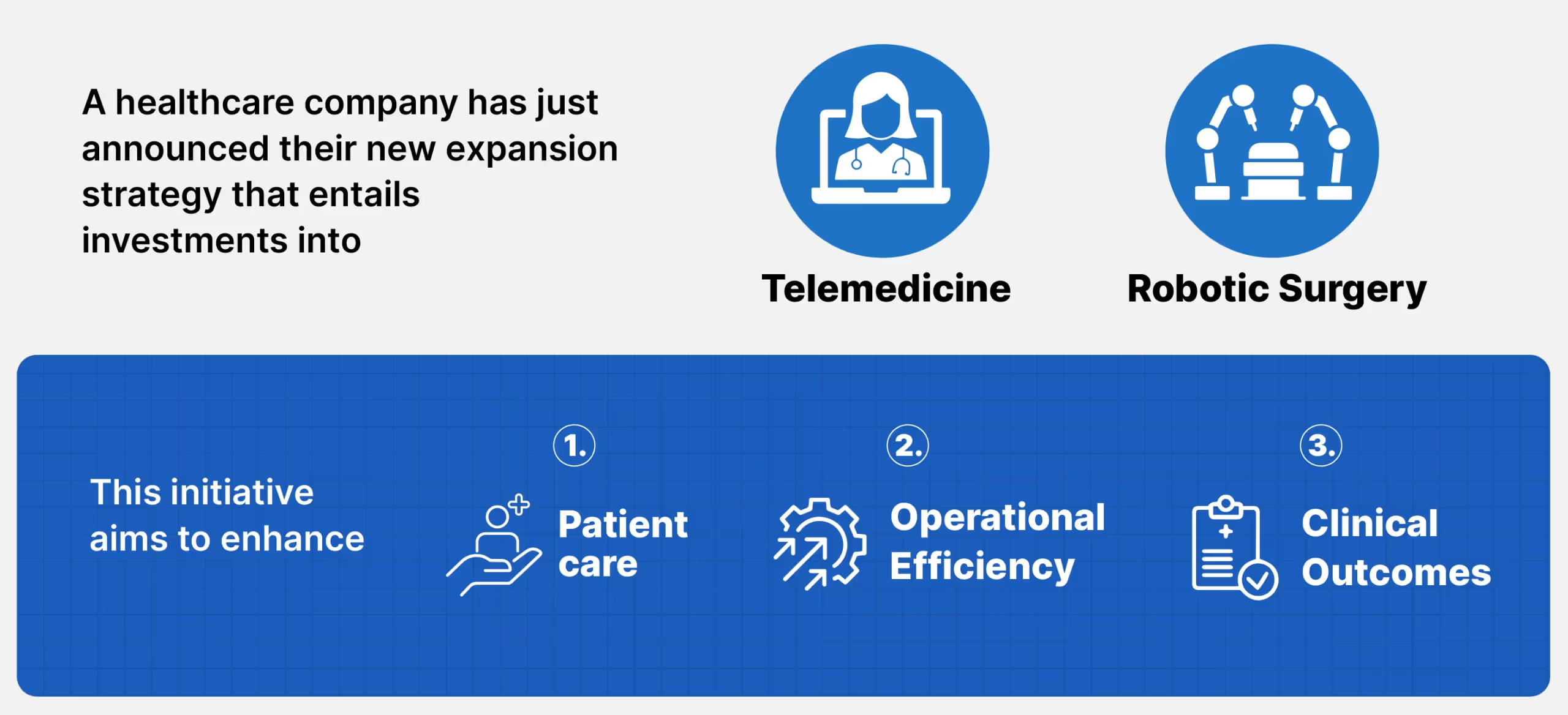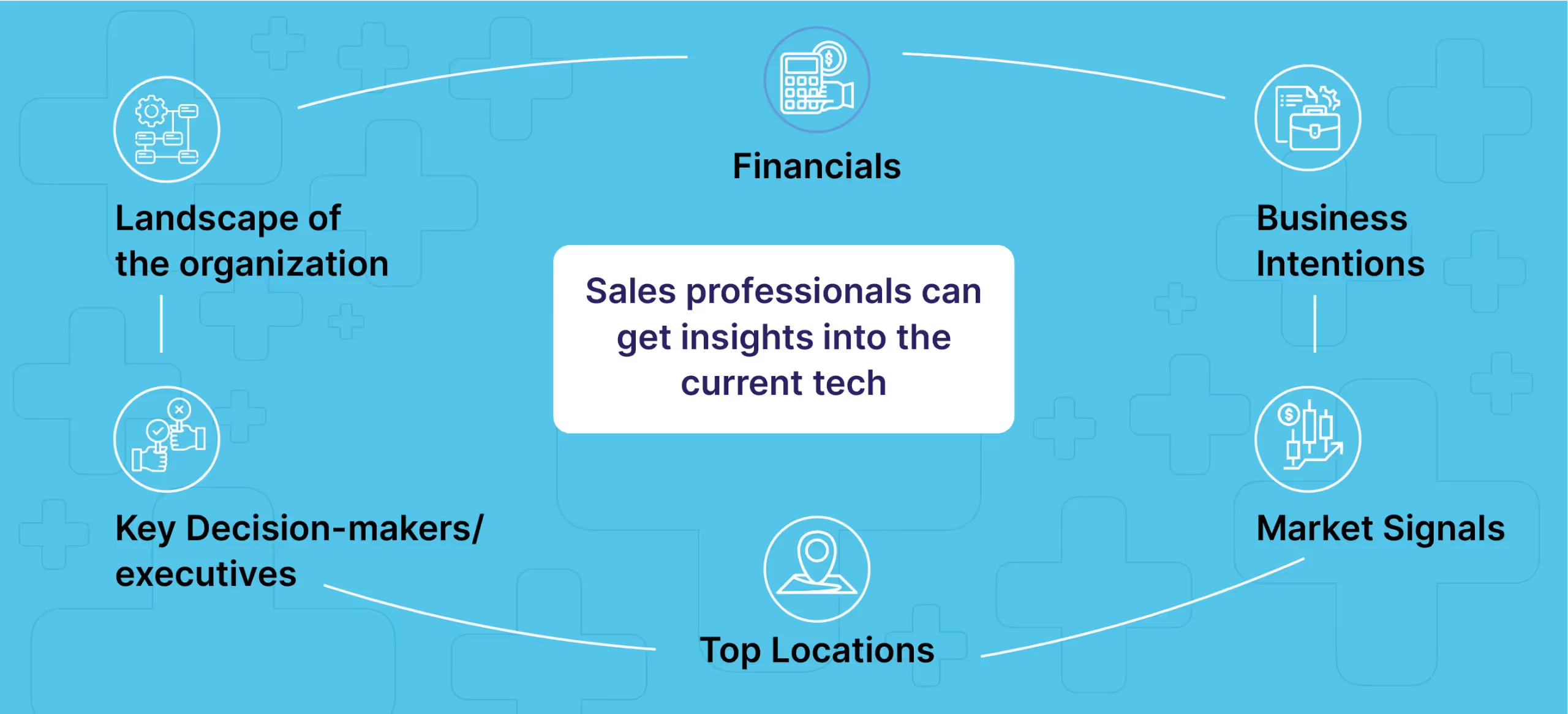Uncover Strategic Market Intelligence with AI-Powered Sales Intelligence Platforms
Salesforce report says top performing sales teams are 3.5 times more likely to leverage sales analytics than underperforming teams. AI-powered Sales Intelligence platforms are fast taking the center stage in enterprise sales motions – due to the quality of market intelligence on serviceable TAM they instantly generate.
AI-powered Sales Intelligence platforms are fast tracking the process of finding the most high -potential target accounts – by tapping in real-time, most relevant market intelligence and actionable signals from the target serviceable market. This really changes the game – ensuring enterprise sales team do not leave out any potential opportunity in the market untapped.
Real-time market signals (like market trends, competitor activities, leadership changes, etc) coupled with deep account – level insights (like current market condition, firmographic data, IT/Tech landscape, outsourcing trends, primary stakeholders/key decision-makers, and business intentions), allows precision targeting. Sales professionals can engage with high-potential prospects by introducing them to the product features and content which resonate with their goals and challenges.
With AI-driven predictive analytics, sales professionals can analyze the trends and patterns to accurately predict market movements, future market trends and customer needs. This allows for better allocation of organizational resources, streamlined sales plan execution, and ability to stay relevant in the market by anticipating and addressing challenges proactively.
Unlock Advanced Market Intelligence and Buyer Intent with AI-powered Sales Intelligence Platforms
Understanding the buyer intent is a critical first step for sales professionals while creating their outreach strategy. By integrating advanced AI capabilities into their process and leveraging the real-time intent insights, sales professionals can easily decode buyer behaviours and market intelligence and signals to capitalize on emerging opportunities.
With real-time buyer and market intelligence, sales professionals can stay up to date with evolving buyer preferences and can have access to market intelligence and signals, real fast. Access to this in-depth data enables personalization of sales strategies which are tailored to individual account/buyer/industry intent signals across various touchpoints.
For example, a healthcare company has just announced their new expansion strategy that entails investments into telemedicine, robotic surgery. This initiative aims to enhance patient care, operational efficiency, and clinical outcomes through advanced technology solutions. Based on this market intelligence on such expansion plans, sales teams can prioritize their target accounts, understand the competitive landscape, identify the incumbent vendors – and tailor their messaging/account penetration plans to drive more success.

Sales professionals can get insights into the current tech landscape of the organization, financials, business intentions, market signals, their top locations, key decision-makers/executives, etc. These data-driven insights can be further drilled down as:
1. Account – Level Intelligence: Primary and secondary verticals, growth and ratios, the tech/IT spend, revenue forecasts, etc.
With this market intelligence data, sales teams can set realistic expectations from the target company (if they have budget allocated for the initiative), adjust their pricing by demonstrating ROI and efficiency gains, and aim to frame their strategy around the same verticals.
For example, the healthcare provider is anticipating a 20% increase in tech/IT spend over the next six months. With this insight, sales professionals can designate it as a high-priority account and allocate their top resources and expertise, securing a buy-in from the key-decision makers involved.
2. Buyer – Level Intelligence: Decision-making engagement, budget control, influence on the deal, buyer’s geographical impact, the overall experience, etc.
The capability to pinpoint the key decision makers and their involvement in the deal allows sales professionals to allocate their resources and time effectively. Also, understanding the key decision maker’s profile (expertise, skills, operational setup) gives a comprehensive understanding of the process workflow, tools they might be using, their hierarchy and the pain points. This allows strategic engagement by aligning the product with decision-maker’s technical knowledge and professional interests, highlighting features and benefits that resonate the most given their requirements.
For example, with this strategic expansion across 10 hospital locations worldwide, the healthcare company is aiming to improve patient care efficiency by 30% over the next year. With targeting the right-decision makers for the project, sales professionals can demonstrate tangible benefits that resonate with decision-makers’ priorities and cater to specific regional needs, maximizing the chances of securing the deal.

3. Industry – Level Intelligence: Emerging industry trends, industry-wise ecosystems, workforce distribution, top roles and technologies in demand, etc.
Having access to the clear 360-view of the ecosystem, sales professionals can have a clear understanding of market intelligence (the workforce distribution across regions) helping in prioritizing territories and allocating resources effectively, ensuring maximum market penetration. Understanding the interconnectedness of various industry players and their dependencies enables sales teams to identify strategic partnerships and collaboration opportunities.
For example, with insights into healthcare ecosystem like a 30% annual increase in demand of AI over three years, sales professionals can strategically position their offerings and emphasize on
4. Competitor Install Base – competitor product usage, penetration in target geographies, industries and accounts etc.
Clear visibility into the competitor’s install base enables sales professionals to customize their solutions and related messaging – to replace/outbid other incumbent vendors. Insights on competitor install base from AI-powered Sales Intelligence platforms can also be leveraged by enterprise sales teams to predict when accounts might switch vendors and plan accordingly.
For example, the healthcare company announces investments in telemedicine and robotic surgery to improve patient care and operational efficiency. AI-powered sales intelligence platforms can help sales teams can identify the competitor’s install base in these areas and understand which vendors are currently serving them to tailor their messaging highlighting the additional benefits their solution can offer. This approach will keep sales efforts aligned with market movements and competitive dynamics, driving greater success in securing new accounts.
Based on these in-depth real-time market intelligence, sales professionals can also cross-sell and upsell knowing their other needs, areas of improvement, and identifying new market entry opportunities, facilitating expansion into new areas of growth. Also, visibility into account-level insights provides potential for deeper penetration including subsidiaries and related business units maximizing revenue potential.
Conclusion
Harnessing real-time market intelligence enables sales professionals identify high-potential target accounts, hyper-personalize their sales strategies factoring in account – level insights, prioritize high-conversion opportunities, and optimize resource allocation. By identifying high-conversion opportunities through detailed market intelligence and predictive analytics, sales teams can prioritize their efforts on prospects most likely to convert, optimizing time and resources effectively.
Moreover, real-time market intelligence empowers sales professionals to adjust their strategies dynamically based on evolving market conditions and competitor activities. Market intelligence on competitor positioning and install base allows sales teams to differentiate their offerings effectively and improve sales closure rates.
AI-powered Sales Intelligence platforms provide in-depth crucial financial insights for sales professionals, including a buyer’s revenue trends, profitability, and budget allocation. These insights help them assess investment capacity and accordingly tailor solutions to align with the financial priorities of the potential account. With AI-powered Sales Intelligence platforms, sales teams can also track recent investments and financial risk indicators, enabling precise targeting and positioning of value propositions to foster stronger, trust-based client relationships.
Companies like Salesforce, Microsoft, Capegemini, Intel, PWC, Genpact, Infosys and many more leverage Draup’s AI powered Sales Intelligence platform to accelerate strategic sales motion and ABM campaigns.
Book a demo now!!









.svg)

.svg)
.svg)
.svg)













.svg)





.svg)





.svg)
